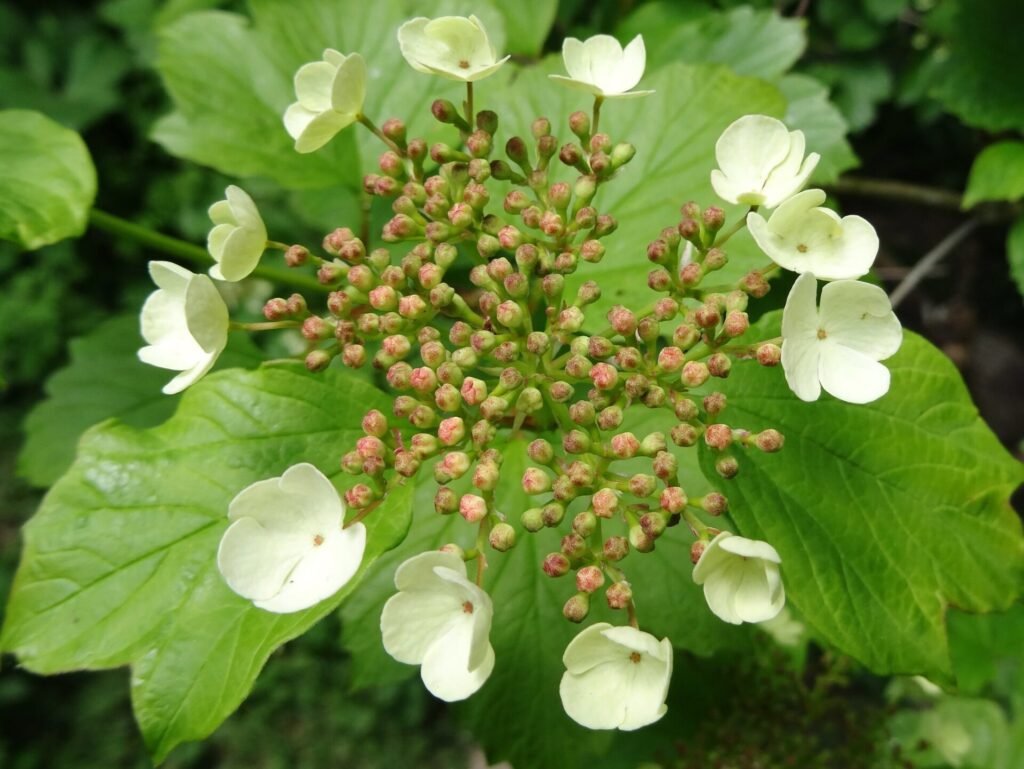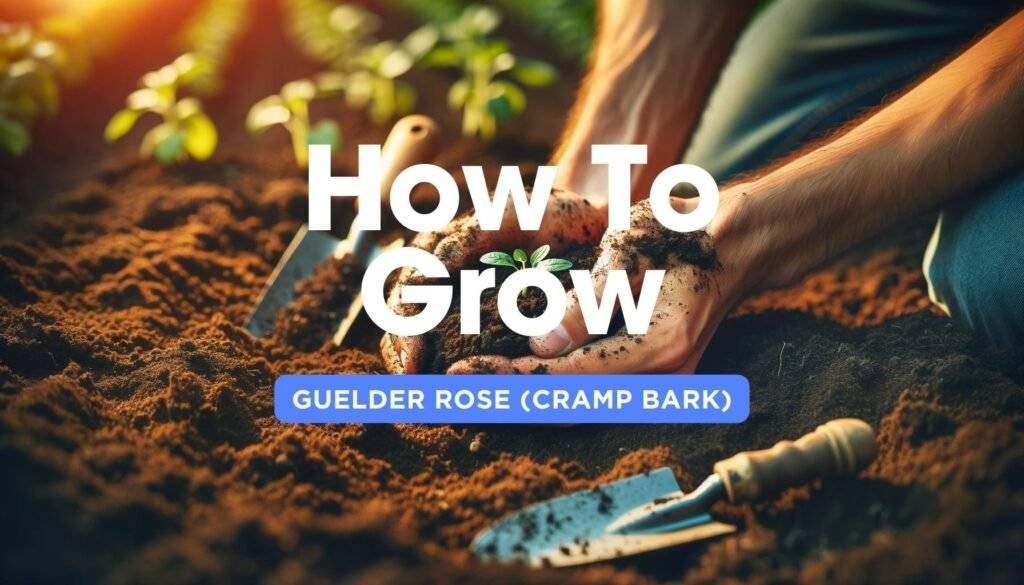Starting Your Guelder Rose (Cramp Bark) Adventure
Greetings, garden lovers! Today, we embark on a delightful journey of growing Guelder Rose, also known as Cramp Bark. This guide complements our earlier article, “What is Cramp Bark,” where we explored its botanical and medicinal virtues. If you’re curious about this plant’s background, that article is a must-read.
In this guide, we’ll focus on the practical aspects of cultivating Guelder Rose in your garden. It’s a journey suited for both experienced gardeners and novices alike, offering beauty and health benefits. We’ll cover the essentials – from selecting the right spot to the basics of care – ensuring a smooth gardening experience.
So, let’s dive into the world of Guelder Rose with enthusiasm and curiosity. We’re here to help you nurture this remarkable plant, enhancing your garden and wellbeing. Remember to check out “Guelder Rose – Viburnum Opulus – Cramp Bark” article for an in-depth understanding of what you’ll be growing. Happy gardening!


Getting Your Guelder Rose Started
Finding the Perfect Spot
The journey of growing Guelder Rose starts with finding the right spot in your garden. This plant is quite adaptable when it comes to light; it can thrive both in gentle shade and in sunny spots. As for the soil, Guelder Rose prefers it to be like a well-wrung sponge – moist yet well-draining. Space is important too, as this plant can grow quite large, reaching heights and widths of 4-5 meters. It’s a plant that loves to stretch out, so make sure it has enough room to flourish.
Planting Step by Step
When it comes to planting your Guelder Rose, timing is key. The best times are during the gentler seasons of spring or autumn. Before planting, enrich the soil with some compost – it’s like a hearty meal for your plant. When you’re ready to put it in the ground, make sure it’s at the same level it was in its pot, and give it plenty of room – about 2-3 meters from other plants. After planting, a thorough watering is crucial. It’s like a welcome drink, helping your plant to settle in its new home.
Watering and Feeding
Watering your Guelder Rose is like tending to a growing friendship – it needs regular attention, especially in dry periods. However, as it matures, you can ease up a bit. Spring is a great time to feed your plant with some general-purpose fertilizer, giving it the boost it needs for the growing season.
Trimming and Health
Pruning your Guelder Rose is best done in late winter or early spring. This is when the plant is ready to be shaped and rid of any dead or overly crowded branches. Pruning not only keeps your plant healthy but also encourages better growth and shape.
Ideas for Your Garden
The Guelder Rose is not just a solitary beauty; it can be used to create a stunning natural hedge. It also pairs wonderfully with other shade-loving plants, offering a harmonious blend in your garden.
Getting Ready for Winter
Preparing your Guelder Rose for winter involves a bit of mulching around its base to protect the roots from the cold. A little pruning to remove any damaged parts can also help it maintain its health and appearance through the colder months.

Dealing with Problems
| Problem | Solution |
|---|---|
| Aphids | A gentle bug spray should keep them at bay. |
| Powdery Mildew | Ensure good air circulation; fungicide can help if needed. |
This guide aims to help you successfully cultivate a thriving Guelder Rose in your garden. Each step, from planting to dealing with common problems, is an integral part of the journey. Enjoy the process of watching your Guelder Rose grow, adding beauty and charm to your garden. Happy gardening!

Pruning and Caring for Your Guelder Rose
Pruning is essential for the health and beauty of your Guelder Rose. It involves removing unwanted branches, which helps in controlling the plant’s size and encourages blooming. Here’s a straightforward guide on how to prune and care for your Guelder Rose, tailored especially for new gardeners.
Pruning Basics
- When to Prune: The ideal time for pruning is late winter or early spring. This timing is perfect because the plant is still dormant but getting ready for new growth.
- How to Prune: Always use sharp pruning shears. This ensures clean cuts that are healthier for the plant. Remove branches that are dead, diseased, or overcrowded. This not only improves the plant’s appearance but also its overall health.
Care Through the Seasons
- Spring: This is a time of new beginnings for your Guelder Rose. Keep an eye out for new shoots. Prune if necessary to shape the plant and encourage healthy growth.
- Summer: The focus in summer is on vigilance. Watch out for any signs of pests or diseases. Addressing these issues promptly can save your plant from further damage.
- Autumn: As the growing season winds down, prepare your Guelder Rose for the colder months. Trim any damaged or broken branches to keep it tidy and healthy.
- Winter: Care during winter is minimal but crucial. Protect the plant from heavy snow or frost damage, mainly through light care and monitoring.
Regular Care Tips
- Prune at the end of winter or start of spring. This sets the stage for healthy growth throughout the year.
- Regularly check the plant for any signs of pests or diseases. Early detection and treatment can prevent many problems.
- Adapt your care routine with the changing seasons. Each season has its own set of requirements for optimal plant health.
By following these simple guidelines, you can ensure that your Guelder Rose remains a vibrant and healthy addition to your garden. Regular pruning and seasonal care are key to nurturing a thriving plant.

Multiplying Your Guelder Rose
Expanding your collection of Guelder Roses can be a rewarding part of gardening. It’s about creating new life from the plant you already cherish. Propagation, the process of growing new plants, can seem daunting at first, but it’s quite straightforward. Let’s dive into how you can successfully increase your Guelder Rose plants.
Different Ways to Propagate
The beauty of Guelder Rose lies in its versatility in propagation. You can use either cuttings or seeds, each with its own unique process:
| Method | Process |
|---|---|
| Cuttings | Ideal for winter (hardwood) or summer (softwood). |
| Seeds | Use seeds from ripe berries. This method is slower but equally effective. |
Growing from Cuttings
Growing Guelder Roses from cuttings involves a few simple steps:
- Choosing Cuttings: Look for healthy, new growth on your plant. These stems should be from this year and yet to flower.
- Preparing Cuttings: Cut these stems into lengths of 15-20 cm, ensuring each piece has 2-3 buds.
- Planting: Plant these cuttings in a mixture of sand and compost. Keep them in a sheltered spot and ensure they remain moist until roots start to form.
Growing from Seeds
If you choose to grow from seeds, here’s what you need to do:
- Collecting Seeds: Harvest seeds from the Guelder Rose berries in autumn.
- Seed Prep: Clean them and undergo a stratification process – this means treating them to simulate winter conditions, enhancing germination.
- Planting Seeds: Plant these seeds in well-drained soil. Cover them lightly and keep the soil in a greenhouse or a cold frame.
Looking After New Plants
- Keep the soil around your new plants consistently moist, but avoid overwatering.
- Initially, place them in a bright location, but away from direct sunlight until they’ve grown stronger.
Tips for Success
- Start with the healthiest part of the plant, whether it’s stems or seeds.
- The right combination of soil and moisture is key to successful growth.
- Remember, propagation is a process that requires patience.
By following these methods, you’ll be able to successfully propagate and grow more Guelder Roses. It’s a delightful way to add more beauty to your garden and witness the cycle of life in these lovely plants.

Helpful Videos on Growing Guelder Rose
Explore our concise, easy-to-follow video guides on growing Guelder Rose (Cramp Bark). They cover everything from planting to care, perfect for gardeners at all levels. These videos make learning both fun and informative.
- Guelder Rose with John Feehan in June, Wildflower of Offaly Series
- How To Prune Viburnum Opulus ‘Roseum’, How To Cut Back Viburnum Opulus, Guelder Rose, Get Gardening
FAQ on Growing Guelder Rose (Cramp Bark)
Welcome to the FAQ section on Growing Guelder Rose, also known as Cramp Bark. Here, we answer your common questions, offering clear guidance for both new and experienced gardeners.
Guelder Rose thrives in moist, well-drained soil. It can tolerate a range of soil types, including clay, loam, and sandy soils.
It prefers partial shade but can also grow well in full sun, provided the soil remains moist.
Water regularly to keep the soil consistently moist, especially during dry spells. Overwatering or waterlogged conditions should be avoided.
Late winter or early spring is ideal, just before new growth begins. This helps to maintain its shape and remove any dead or damaged branches.
Yes, it is quite hardy and can tolerate frost. However, young plants may need protection in their first winter.
Regularly inspect your plant for signs of pests or disease. Mild insecticidal soap can manage most pests, and fungicides can help with fungal diseases.
Yes, it can be grown in a large pot with adequate drainage. However, regular watering and feeding are more crucial in a container setting.
It has a moderate growth rate. In ideal conditions, you can expect it to grow around 30-60 cm per year.
Cramp Bark typically blooms in late spring to early summer, with the flowers lasting several weeks.
The berries usually develop in late summer and can last well into the winter, providing food for wildlife.
Its flowers attract pollinators like bees and butterflies, and the berries are a food source for birds in winter.
Yes, it can be combined with other shrubs and perennials. Just ensure each plant has enough space and resources to grow.
Yellowing leaves could be a sign of overwatering, poor drainage, or nutrient deficiency. Adjust your watering schedule and consider soil testing for nutrient levels.
Thank you for exploring our FAQs. We hope these answers make your Guelder Rose gardening experience more enjoyable and successful.

